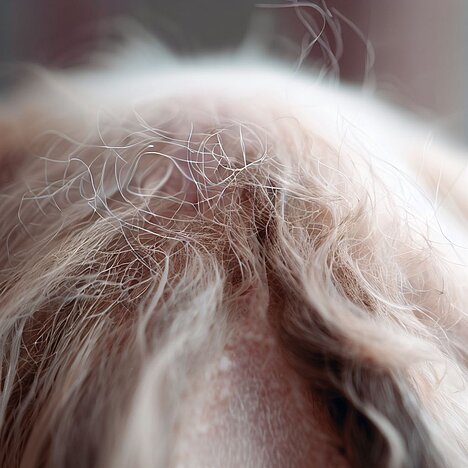Hair loss

Hair loss in dogs is a common problem that can have many causes. In this article, you will learn how to recognize the symptoms, what the possible causes are and how you can help your dog.
Symptoms of hair loss in dogs
Hair loss in dogs can manifest itself in various ways. The most common signs are
- Bald patches or thinning fur in certain areas or all over the body
- Dandruff, crusts or redness on the skin
- Itching, scratching or licking of the affected areas
- Changes in behavior, such as restlessness, nervousness or depression
If you notice one or more of these symptoms in your dog, you should consult a vet to make an accurate diagnosis and find the right treatment.
Possible causes of hair loss in dogs
Hair loss in dogs can have various causes, which can vary depending on breed, age, sex and health status. The most common causes are
- Parasites, such as fleas, mites or fungi, which can irritate the skin and lead to inflammation
- Allergies, such as food allergies, contact allergies or environmental allergies, which can trigger an overreaction of the immune system
- Hormonal disorders, such as hypothyroidism, adrenal hyperfunction or diabetes, which can affect the metabolism and hair growth
- Genetic predisposition, such as alopecia areata, alopecia X or seasonal hair loss, which can lead to hereditary hair loss
- Stress, such as trauma, anxiety or boredom, which can lead to increased scratching or licking of the skin
- Nutritional deficiencies, such as iron deficiency, zinc deficiency or protein deficiency, which can lead to poor hair quality and a weak immune system
Treatment of hair loss in dogs
The treatment of hair loss in dogs depends on the underlying cause. In most cases, medical treatment is necessary to alleviate the symptoms and address the cause. The most common treatments are:
- Parasite control, such as flea medication, mite medication or antifungals, which can kill the parasites and heal the skin
- Allergy therapy, such as antihistamines, corticosteroids or immunotherapy, which can suppress the allergic reaction and reduce inflammation
- Hormone therapy, such as thyroid hormones, adrenal hormones or insulin, which can regulate hormone levels and promote hair growth
- Genetic therapy, such as melatonin, cyclosporine or immunomodulators, which can modulate the immune system and stimulate hair growth
- Stress management, such as behavioral therapy, sedatives or environmental adjustment, which can reduce stress and increase well-being
- Dietary changes, such as high-quality food, supplements or special diets that can meet nutritional needs and strengthen the immune system
In addition to medical treatment, you can also help your dog with some home remedies. For example, you can:
- Brush and groom the coat regularly to remove dandruff and promote circulation
- Cleanse and moisturize the skin with mild shampoos or natural oils to prevent irritation and speed up healing
- Cover the affected areas with soft cloths or bandages to prevent scratching or licking and avoid infection
- Give your dog lots of love and attention to boost their confidence and increase their zest for life
Hair loss in dogs is a serious problem that should not be ignored. If you want to help your dog, you should take the symptoms seriously, find out the cause and apply the right treatment. With the right care and support, you can help your dog to have a healthy and shiny coat.
The authors assume that a veterinarian should be consulted if an animal is ill and that medication should only be taken after consultation with a doctor or pharmacist. Only an individual examination can lead to a diagnosis and treatment decision.
We help you find the nearest vet → This way